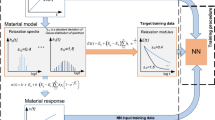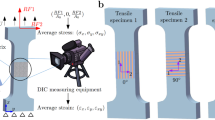Abstract
Two alternative methods for the stress–strain curve determination in the large strains region are proposed. Only standard force–elongation response is needed as an input into the identification procedure. Both methods are applied to eight various materials, covering a broad spectre of possible ductile behaviour. The first method is based on the iterative procedure of sequential simulation of piecewise stress–strain curve using the parallel finite element modelling. Error between the computed and experimental force–elongation response is low, while the convergence rate is high. The second method uses the neural network for the stress–strain curve identification. Large database of force–elongation responses is computed by the finite element method. Then, the database is processed and reduced in order to get the input for neural network training procedure. Training process and response of network is fast compared to sequential simulation. When the desired accuracy is not reached, results can be used as a starting point for the following optimization task.






















Similar content being viewed by others
References
Alexandrov, S., Jeng, Y.-R.: An efficient method for the identification of the modified Cockroft–Latham fracture criterion at elevated temperature. Arch. Appl. Mech. 83, 1801–1804 (2013)
Bobyr, M., Altenbach, H., Khalimon, O.: On the application of the continuum damage mechanics to multi-axial low-cyclic damage. Arch. Appl. Mech. 85, 455–468 (2015)
Šebek, F., Kubík, P., Hůlka, J., Petruška, J.: Strain hardening exponent role in phenomenological ductile fracture criteria. Eur. J. Mech. A/Solids 57, 149–164 (2016)
Mirzajanzadeh, M., Canadinc, D.: A microstructure-sensitive model for simulating the impact response of a high-manganese austenitic steel. J. Eng. Mater. Technol. 138, 041004-1–041004-14 (2016)
Abendroth, M., Kuna, M.: Identification of ductile damage and fracture parameters from the small punch test using neural networks. Eng. Fract. Mech. 73, 710–725 (2006)
Bridgman, P.W.: Studies in Large Plastic Flow and Fracture: With Special Emphasis on the Effects of Hydrostatic Pressure. Harvard University Press, Cambridge (1964)
Zhang, Z.L., Hauge, M., Ødegård, J., Thaulow, C.: Determining material true stress–strain curve from tensile specimens with rectangular cross-section. Int. J. Solids Struct. 36, 3497–3516 (1999)
Mirone, G.: A new model for the elastoplastic characterization and the stress–strain determination on the necking section of a tensile specimen. Int. J. Solids Struct. 41, 3545–3564 (2004)
Joun, MS., Eom, J.G., Lee, M. Ch.: A new method for acquiring true stress–strain curves over a large range of strains using a tensile test and finite element method. Mech. Mater. 40, 586–593 (2008)
Koc, P., Štok, B.: Computer-aided identification of the yield curve of a sheet metal after onset of necking. Comput. Mater. Sci. 31, 155–168 (2004)
Kamaya, M., Kawakubo, M.: A procedure for determining the true stress–strain curve over a large range of strains using digital image correlation and finite element analysis. Mech. Mater. 43, 243–253 (2011)
Lüders, W.: Über die Äueßerung der Elasticität an stahlartigen Eisenstäben und Stahlstäben, und über eine beim Biegen solcher Stäbe beobachtete Molecularbewegung. Polytech. J. 155, 18–22 (1860)
Kim, J.-H., Serpantié, A., Barlat, F., Pierron, F., Lee, M.-G.: Characterization of the post-necking hardening behaviour using the virtual fields method. Int. J. Solids Struct. 50, 3829–3842 (2013)
Landron, C., Maire, E., Bouaziz, O., Adrien, J., Lecarme, L., Bareggi, A.: Validation of void growth models using X-ray microtomography characterization of damage in dual phase steels. Acta Mater. 59, 7564–7573 (2011)
Kõrgesaar, M., Romanoff, J.: Influence of softening on fracture propagation in large-scale shell structures. Int. J. Solids Struct. 50, 3911–3921 (2013)
Longère, P., Dragon, A.: Description of shear failure in ductile metals via back stress concept linked to damage-microporosity softening. Eng. Fract. Mech. 98, 92–108 (2013)
Zhou, J., Gao, X., Sobotka, J.C., Webler, B.A., Cockeram, B.V.: On the extension of the Gurson-type porous plasticity models for prediction of ductile fracture under shear-dominated conditions. Int. J. Solids Struct. 51, 3273–3291 (2014)
Morin, L., Kondo, D., Leblond, J.-B.: Numerical assessment, implementation and application of an extended Gurson model accounting for void size effects. Eur. J. Mech. A/Solids 51, 183–192 (2015)
Nurcheshmeh, M., Green, D.E.: Prediction of forming limit curves for nonlinear loading paths using quadratic and non-quadratic yield criteria and variable imperfection factor. Mater. Des. 91, 248–255 (2016)
Malcher, L., Reis, F.J.P., Andrade Pires, F.M., César de Sá, J.M.A.: Evaluation of shear mechanisms and influence of the calibration point on the numerical results of the GTN model. Int. J. Mech. Sci. 75, 407–422 (2013)
Khadyko, M., Dumoulin, S., Børvik, T., Hopperstad, O.S.: An experimental-numerical method to determine the work-hardening of anisotropic ductile materials at large strains. Int. J. Mech. Sci. 88, 25–36 (2014)
Voce, E.: A practical strain-hardening function. Metallurgia 51, 219–226 (1955)
Abbassi, F., Belhadj, T., Mistou, S., Zghal, A.: Parameter identification of a mechanical ductile damage using Artificial Neural Networks in sheet metal forming. Mater. Des. 45, 605–615 (2013)
Roth, Ch.C., Mohr, D.: Effect of strain rate on ductile fracture initiation in advanced high strength steel sheets: experiments and modelling. Int. J. Plast. 56, 19–44 (2014)
Acknowledgements
This work is an output of project NETME CENTRE PLUS (LO1202) created with financial support from the Ministry of Education, Youth and Sports under the “National Sustainability Programme I”. The authors would also like to thank the Institute of Physics of Materials of the Academy of Sciences of the Czech Republic, v. v. i. for providing the experimental data.
Author information
Authors and Affiliations
Corresponding author
Appendix
Appendix
Results of the flow curve identification performed by the above-mentioned methods are shown in the following Figs. 15, 16, 17, 18, 19, 20, 21 and 22. The flow curves identified by the sequential simulation are designated as SEQ. The label SEQ-fit was used for the fitted curves using Eq. (8) serving as the parametric estimate of the flow curve for the extrapolation or for the optimization task. Curves identified by the neural network are labelled as NN.
Rights and permissions
About this article
Cite this article
Jeník, I., Kubík, P., Šebek, F. et al. Sequential simulation and neural network in the stress–strain curve identification over the large strains using tensile test. Arch Appl Mech 87, 1077–1093 (2017). https://doi.org/10.1007/s00419-017-1234-0
Received:
Accepted:
Published:
Issue Date:
DOI: https://doi.org/10.1007/s00419-017-1234-0




